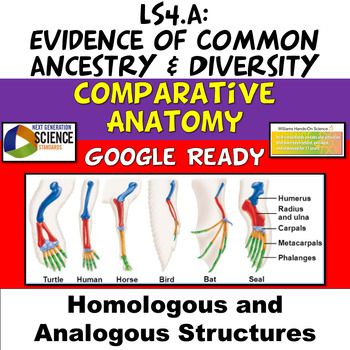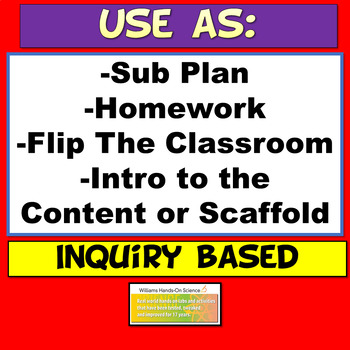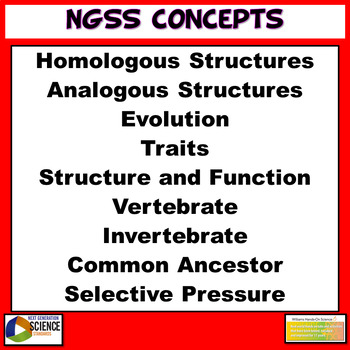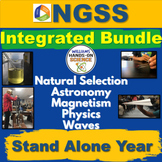Evidence of Evolution Common Ancestry NGSS LS4.A Worksheet Digital Activity
- Zip
- Google Apps™

What educators are saying
Also included in
- Looking for a complete, standalone year-long curriculum for integrated NGSS Physics, Energy, Waves, Astronomy, Earth’s History, Science and Engineering Practices, Crosscutting Concepts, and Evolution? Look no further than this student-centered, inquiry-based, hands-on bundle! Designed to align withPrice $205.00Original Price $366.00Save $161.00
Description
If you are teaching NGSS Disciplinary Core Ideas LS4.A: Evidence of Common Ancestry and Diversity, this resource is perfect for you! Students first use their background knowledge and attempt to answer questions about the comparative anatomy of a turtle, human, horse, bird, bat and seal. This is a great exercise in met-cognition for the last 4 questions. Students do the same with a bird, bat and bee. Students then do research on the differences between Homologous and Analogous structures. Students quickly learn that the turtle, human, horse, bird, bat and seal all have homologous structures and that the bird, bat and bee have analogous structures. This is great for meta-cognition, critical thinking and rich class discussions. This resource is approximately 50 minutes.
If you like this product, check out the bundle it's included in:
Evolution LS4.A LS4.B LS4.C Google Ready Growing Bundle Natural Selection!
This product Includes the following:
-Student Handout
-Editable PowerPoint for classroom management and student instructions
-Link to make a copy for Google Classroom
-Editable Key
This resource has the following NGSS Standards:
NGSS Disciplinary Core Ides (DCI):
Anatomical similarities and differences between various organisms living today and between them and organisms in the fossil record, enable the reconstruction of evolutionary history and the inference of lines of evolutionary descent. (MS-LS4-2)
NGSS Cross Cutting Concepts (CCC)
Crosscutting Concepts
Patterns:
Patterns can be used to identify cause and effect relationships. (MS-LS4-2)
Graphs, charts, and images can be used to identify patterns in data. (MS-LS4-1),(MS-LS4-3)
Cause and Effect:
Phenomena may have more than one cause, and some cause and effect relationships in systems can only be described using probability.
Structure and Function:
Complex and microscopic structures and systems can be visualized, modeled, and used to describe how their function depends on the shapes, composition, and relationships among its parts; therefore, complex natural and designed structures/systems can be analyzed to determine how they function. (MS-LS3-1)
This resource has the following concepts:
Homologous Structures
Analogous Structures
Comparative Anatomy
Evolution
Traits
Structure and Function
Vertebrate
Invertebrate
Common Ancestor
Selective Pressure
If there are any errors or questions, please contact me through TpT or email me at:
williamshandsonscience@gmail.com
TERMS OF USE
• All rights reserved by Williams Hands On Science, Inc.
• This product is to be used by the original purchaser only.
• Intended for classroom and personal use only.
• Copying for more than one teacher, classroom, department, school, or school system is prohibited.
• This product may not be distributed or displayed digitally for public view.
• Failure to comply is a copyright infringement and a violation of the Digital Millennium Copyright Act (DMCA).
If there are any errors or questions, please contact me through TpT or email me at:
williamshandsonscience@gmail.com
Thank you for taking a look!
Please follow me on TpT for new products and check me out on Instagram for my products in action!
https://www.instagram.com/williams_hands_on_science/
Related Products
⭐ 6th 7th or 8th Grade NGSS Genetic Variation/Growth and Development of Organisms
⭐ Claim Evidence Reasoning ESS1.C History of Earth Permian Triassic Extinction
⭐ Claim Evidence Reasoning Human Evolution MS-LS4-1 HS-LS4-2 HS-LS4-1 MS-LS4-2
⭐ Claim Evidence Reasoning Plate Tectonics Pangaea Article and Graphic Organizer
⭐ Claim Evidence Reasoning: Evidence from Oldest DNA Shows Common Ancestry
⭐ MS-LS4-1: NGSS Geologic Time Scale Card Sort
⭐ NGSS 5E Natural Selection Computer Simulation
⭐ NGSS Claim Evidence Reasoning (CER) Oldest Evidence of Life on Land Found
⭐ NGSS Claim Evidence Reasoning: Proof That Earth Is in Its 6th Mass Extinction
⭐ NGSS LS3.A LS3.B Inheritance & Variation of Traits PowerPoint Google Slides
⭐ NGSS LS4.B: Natural Selection and LS4.C: Adaptations Video & Guided Questions
⭐ NGSS Mysterious New Form of DNA Claim Evidence Reasoning Graphic Organizer






